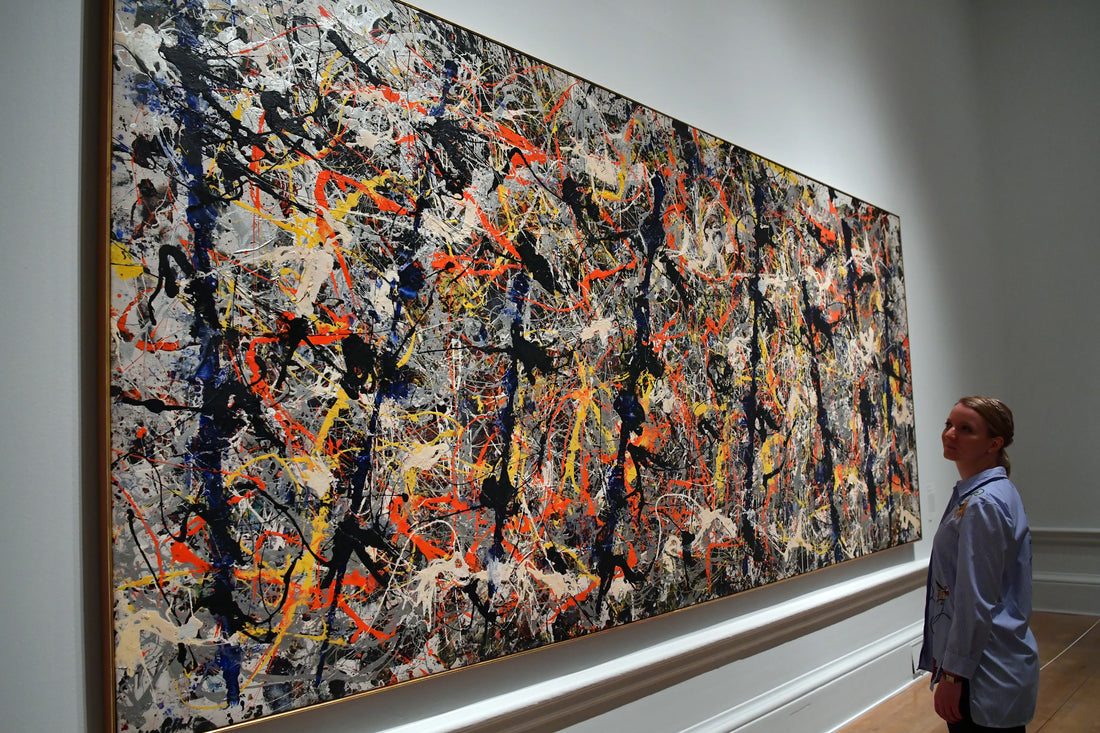
Ken Griffin’s Enduring Fascination with Jackson Pollock’s Iconic Blue Poles - An Intersection of Art, Legacy, and Controversy
Share
In the international art collecting realm, few stories resonate like the hedge-fund titan Ken Griffin’s passionate admiration for Jackson Pollock’s monumental work Blue Poles. This artwork, officially known as Number 11, 1952, stands as one of the most celebrated masterpieces of Abstract Expressionism. Despite Griffin owning several Pollock paintings, including the renowned Number 17A, his declared favorite remains Blue Poles, a painting held by the National Gallery of Australia since its bold acquisition in 1973.
Completed in 1952, Blue Poles epitomizes Pollock’s pioneering drip painting technique, where the artist abandoned traditional brushes for unconventional tools, splattering and pouring paint onto unstretched canvas. This large-scale abstract painting stretches 18 feet wide, characterized by energetic strokes and eight distinct blue poles intersecting the chaotic background. It marks a critical transitional point in Pollock’s artistic journey, where he consciously introduced a stronger sense of composition while maintaining his iconic ‘all-over’ painting style. Pollock's Blue Poles visually embodies his revolutionary approach that helped redefine 20th-century art and is widely regarded as an Abstract Expressionism masterpiece.

Ken Griffin once candidly shared during an interview with Stanford Business School Insights how he tried to purchase Blue Poles from the National Gallery of Australia, offering several hundred million dollars. Yet, the painting remains in Australia, symbolic of the museum's cultural heritage and the turbulent history of its acquisition. The National Gallery of Australia purchase of Blue Poles stirred significant controversy at the time—it cost 1.3 million Australian dollars, a record for an American painting, provoking fierce political and public debate. Australian Prime Minister Gough Whitlam personally approved the purchase, underlining its importance as a cultural investment for the nation.
Blue Poles has grown in reputation and value, initially ridiculed but now celebrated as a national treasure. The painting was loaned internationally, including a major retrospective at the Museum of Modern Art (MoMA) in 1998, and featured in the Royal Academy’s Abstract Expressionism exhibition in London in 2016. Recent conservation efforts by the National Gallery underscore the painting’s importance and fragility, ensuring its preservation for future generations.
Griffin’s obsession with Pollock extends beyond Blue Poles. His acquisition of Pollock’s Number 17A for a staggering $200 million further secures his status as a foremost contemporary art patron. Both works highlight Pollock’s lasting impact on the art market, where Abstract Expressionism continues to command extraordinary prices and collector interest. The story of Blue Poles illustrates the dynamic tension between private collectors and public institutions in holding cultural artifacts of global significance.
Image Sources
-
Blue Poles at the National Gallery of Australia (source: National Gallery of Australia official website)
-
Ken Griffin portrait from Stanford Business School Insights (source: Stanford GSB)
-
Pollock’s Number 17A (source: Museum of Modern Art archives)
Related Keywords and Anchor Links
Ken Griffin’s immense art collection, including Pollock’s Number 17A, showcases a deep study and patronage of postwar American art and Abstract Expressionism, which challenged traditional artistic conventions. The National Gallery of Australia’s controversial acquisition of Blue Poles represents a turning point in Australian cultural history and symbolizes evolving attitudes toward modern art.
The painting’s title Blue Poles was reportedly suggested by Pollock himself, differing from his typical numeric titling system, and is often discussed in art historical circles for how it shapes viewer interpretation. The movement surrounding Abstract Expressionism, which Pollock helped spearhead, remains a defining chapter of 20th-century art history, transforming visual art practices and collectors’ aspirations globally.
Frequently Asked Questions
Q1: What is Jackson Pollock’s Blue Poles?
Blue Poles (officially Number 11, 1952) is a large-scale Abstract Expressionist drip painting famous for its dynamic composition and technique, held by the National Gallery of Australia since 1973.
Q2: Why was the purchase of Blue Poles controversial?
The Australian government’s 1973 purchase for 1.3 million Australian dollars was unprecedented and sparked public debate over spending on modern American art, a move that polarized opinion and tested cultural priorities.
Q3: Who is Ken Griffin, and why is Blue Poles significant to him?
Ken Griffin is a billionaire hedge fund manager and art collector who admires Blue Poles as his favorite artwork, even offering hundreds of millions to acquire it, reflecting its enduring importance in the art market.
Q4: Where has Blue Poles been exhibited internationally?
The painting has been on display at major institutions including the Museum of Modern Art in New York and the Royal Academy of Arts in London.
Q5: What makes Pollock’s works highly valuable in today’s art market?
Pollock’s innovation in abstract painting and his cultural impact as a pioneer of Abstract Expressionism has made his works highly sought after, setting record prices such as Griffin’s $200 million purchase of Number 17A.
Q6: Where can the public view Blue Poles?
Blue Poles is permanently exhibited at the National Gallery of Australia in Canberra, attracting visitors worldwide.
Ken Griffin’s fascination with Blue Poles highlights the interplay between art history, collector passion, and national heritage. This painting’s journey from controversy to a treasured masterpiece perfectly encapsulates the transformative power of art and its deep cultural significance across continents.
